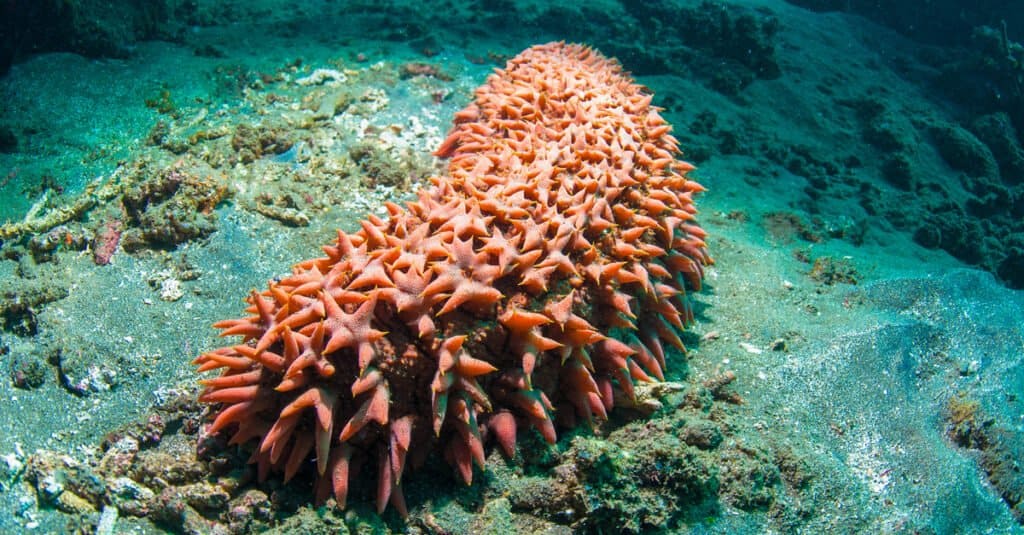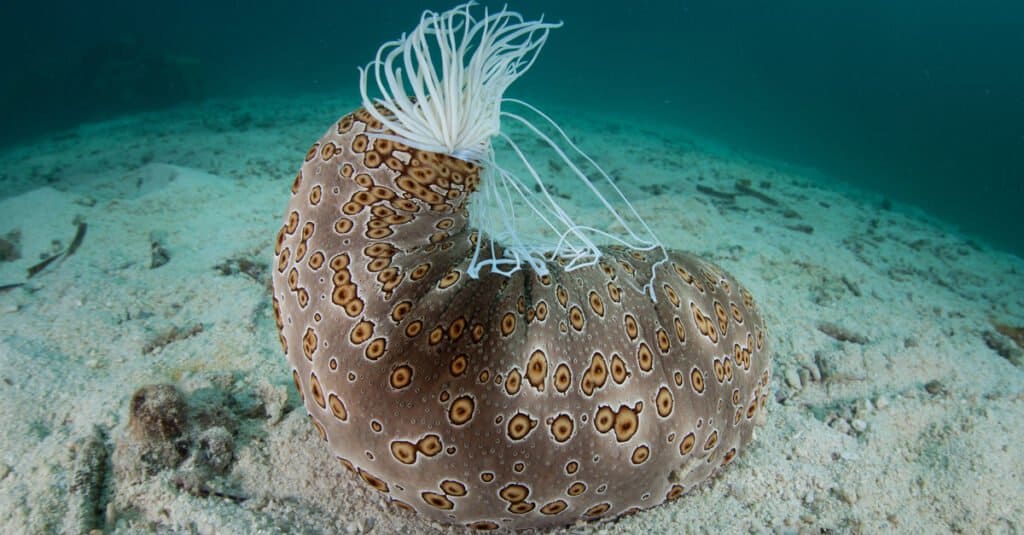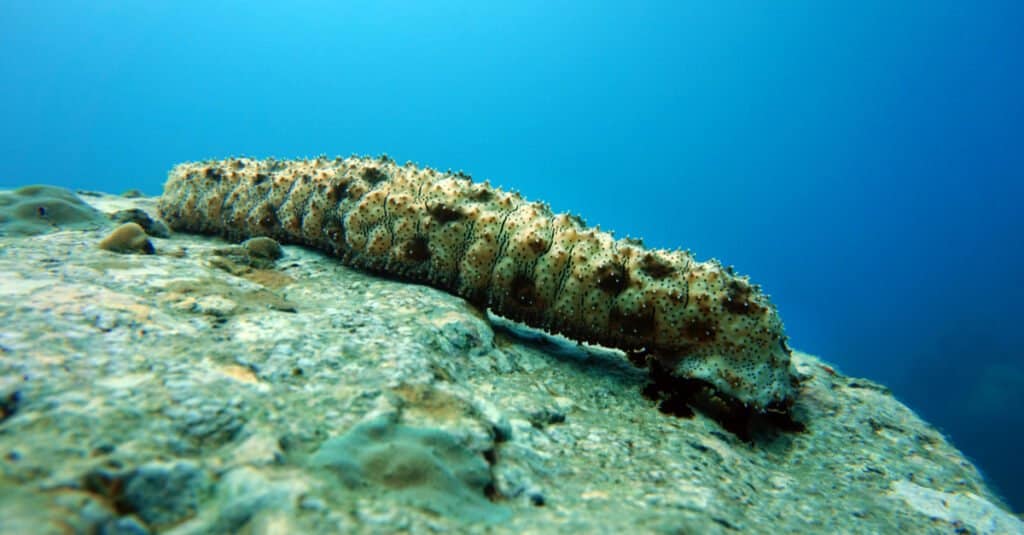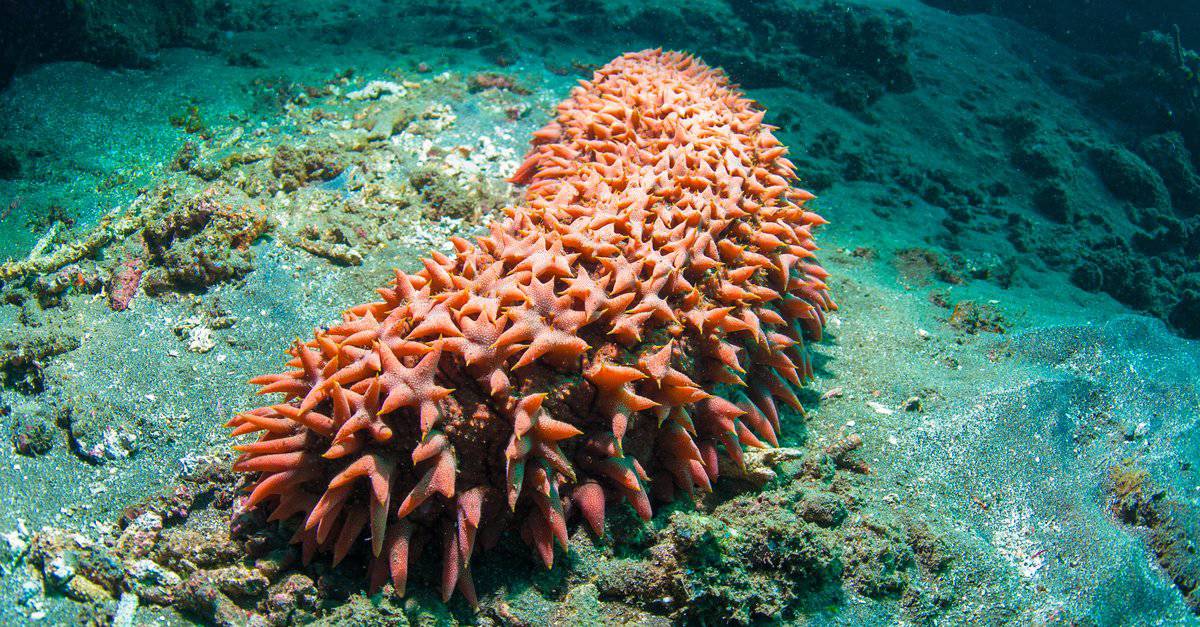Sea cucumbers are part of echinoderms’ animal group, containing urchins, sand dollars, and starfish. They are found in nearly all marine environments throughout the world.
Sea cucumbers are named for their strange elliptical shape that looks like a fat cucumber. They are invertebrates of varying sizes (can grow as much as over 6 feet in length). Sea cucumbers have soft bodies with no faces or eyes. They grow between 20 to 30 tentacle-like tube feet around their mouths and are generally not a good sight to behold.
This article will help you satisfy your curiosity on what sea cucumbers eat, their mode of feeding, and how they generally survive.
What Do Sea Cucumbers Eat?

Sea cucumbers eat tiny particles like algae, small animals, and waste products, and they are predominantly omnivores. Recently, it has been established that sea cucumbers eat seagrass, although they wouldn’t go looking for seagrass out in the wild.
A complete list of food sea cucumbers eat:
- Algae
- Bacteria
- Seagrass and seagrass sediments
- Plankton
- Decaying organic materials
- Waste material
- Other minute organisms
Sea cucumbers are not the most proficient hunters in the sea. Hence they are generally scavengers. They eat scattered waste in the benthic region of the sea. The diet of most sea cucumbers consists of algae, plankton, and decaying organic matter.
Many Sea cucumbers take positions in the currents and catch food with their wide opened tentacles on their mouths. Also, they filter through the ocean bottom residues utilizing these tentacles.
Furthermore, sea cucumbers dig into the sand until they are almost covered while releasing their feeding tentacles. Their tentacles are structured to fit the diet and size of the food taken. The suspension-feeding species have tree-like tentacles to maximize the surface area available for sifting. In contrast, sea cucumber species that get their food from the sea bottom have finger-like tentacles to obtain nutritional materials.
Lastly, the burrowing species have shorter shield-shaped tentacles for easy digging. Sea cucumbers eat day and night, and their feeding mechanism supports decomposition.
How Do Sea Cucumbers Survive During Unfavorable Weather Conditions Or Limited Food Supply?

Sea cucumbers are both omnivores and scavengers
©e2dan/Shutterstock.com
Sea cucumbers don’t simply perish when the weather conditions are not conducive for them or when there is little or no food to consume. Instead, they stop feeding and slow down their metabolism, making them lose weight and shrink. Sometimes, a sea cucumber eats itself when it starves, gradually becoming smaller.
What Are Sea Cucumbers’ Predators?
The vast majority of marine hunters frequently overlook sea cucumbers due to the toxins they have and their spectacular defensive framework. Nevertheless, they remain hunted by some predators who are not affected by their toxins.
The giant mollusk is an example of a sea cucumber’s predator that paralyzes it by utilizing a toxic secretion before ingesting it as a whole. In addition, some other opportunistic predators can also go after sea cucumbers, especially when they are in short supply of better foods. Such predators include:
- Tigerfish
- Putter fish
- Crabs
- Lobsters
- Sea turtles
- Some shark species
How Do Sea Cucumbers Defend Against Predators?

Sea cucumbers can release tubules to protect themselves from threats.
©Ethan Daniels/Shutterstock.com
Many sea cucumbers protect themselves from harm by forcefully releasing their tacky tubules (the amplification of the respiratory tree that floats in the coelom) to entrap possible hunters.
When alarmed, they shoot these tubules via a tear in the mass of the cloaca with the sole purpose of destroying the predator. The organ is grown back after 2 to 5 weeks. Also, the release of these tubules is accompanied by a toxic chemical discharge that can kill animals close by.
Furthermore, they can also assume a solid substance, making it hard for their predators to swallow them.
Benefits Of The Dietary Process Of Sea Cucumbers To The Environment

Sea Cucumbers eat organic waste products and this benefits the sea environment.
©Natalia Siiatovskaia/Shutterstock.com
Sea cucumbers are very important to the sea ecosystem, thanks to their feeding mechanism. As they move around the ocean bottom, eating and pooping, sea cucumbers assist with the dispersion of supplements and elimination of excess organic substances from the water and sediment.
In addition, they help to dissolve calcium carbonate and release it back into the sea, thereby providing materials that corals require to build their exoskeleton. Considerable levels of calcium carbonate also serve as a buffer against acidification by increasing the alkalinity of the water.
The Interaction Of Humans And Sea Cucumbers?
At the sound of the name sea cucumbers, as expected, you may think it is some vegetables found in the sea that you can add to your salads. It is certainly not so; regardless, people eat some species of sea cucumbers after subjecting them to a series of cooking processes, especially in Asia.
It is common to eat sea cucumbers raw, pickled, or fried like many fish. They are known to have a bland taste and slippery texture, and most times, the flavor from meats and spices is added to make them fit to eat for humans.
According to a report in 2010 by the Food and Agriculture Organization of the United States, sea cucumbers are fished and exported mainly to Asian markets where it is highly regarded as a delicacy.
Apart from the vulnerability of sea cucumbers’ larvae and the culinary appeal humans derive from these animals, their medicinal effects put them at the risk of extinction.
Fun Facts About Sea Cucumbers
Sea cucumbers possess some unique features, and some of these facts are listed below.
- Every species of sea cucumbers have its breathing organ (butt lungs) in the anal part of its body. With the respiratory organ, oxygen is removed from the water.
- Some pearlfish species take shelter in the anus of sea cucumbers.
- Their females are hermaphroditic (having both male and female organs of reproduction). Fertilization in sea cucumbers occurs externally where many sperm and eggs are released in the same environment by a group of sea cucumbers of both sexes.
Thank you for reading! Have some feedback for us? Contact the AZ Animals editorial team.








